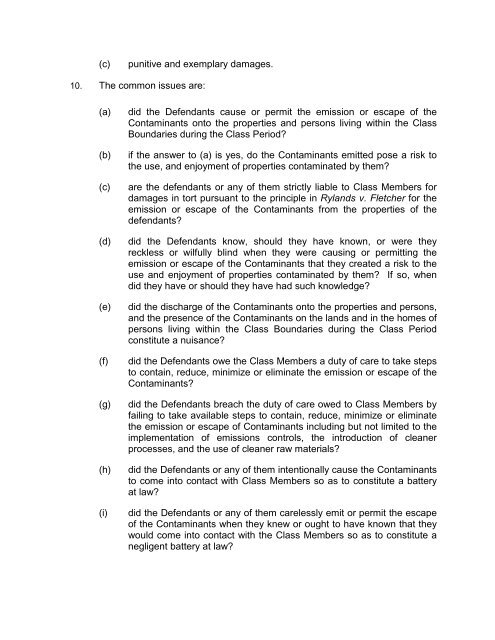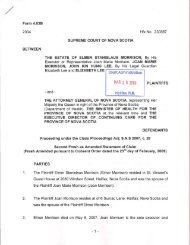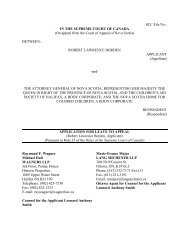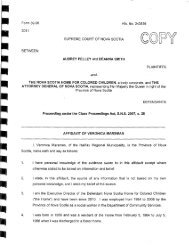May 1, 2012 - Final Certification Order - Wagners
May 1, 2012 - Final Certification Order - Wagners
May 1, 2012 - Final Certification Order - Wagners
Create successful ePaper yourself
Turn your PDF publications into a flip-book with our unique Google optimized e-Paper software.
(c)<br />
punitive and exemplary damages.<br />
10. The common issues are:<br />
(a)<br />
(b)<br />
(c)<br />
(d)<br />
(e)<br />
(f)<br />
(g)<br />
(h)<br />
(i)<br />
did the Defendants cause or permit the emission or escape of the<br />
Contaminants onto the properties and persons living within the Class<br />
Boundaries during the Class Period<br />
if the answer to (a) is yes, do the Contaminants emitted pose a risk to<br />
the use, and enjoyment of properties contaminated by them<br />
are the defendants or any of them strictly liable to Class Members for<br />
damages in tort pursuant to the principle in Rylands v. Fletcher for the<br />
emission or escape of the Contaminants from the properties of the<br />
defendants<br />
did the Defendants know, should they have known, or were they<br />
reckless or wilfully blind when they were causing or permitting the<br />
emission or escape of the Contaminants that they created a risk to the<br />
use and enjoyment of properties contaminated by them If so, when<br />
did they have or should they have had such knowledge<br />
did the discharge of the Contaminants onto the properties and persons,<br />
and the presence of the Contaminants on the lands and in the homes of<br />
persons living within the Class Boundaries during the Class Period<br />
constitute a nuisance<br />
did the Defendants owe the Class Members a duty of care to take steps<br />
to contain, reduce, minimize or eliminate the emission or escape of the<br />
Contaminants<br />
did the Defendants breach the duty of care owed to Class Members by<br />
failing to take available steps to contain, reduce, minimize or eliminate<br />
the emission or escape of Contaminants including but not limited to the<br />
implementation of emissions controls, the introduction of cleaner<br />
processes, and the use of cleaner raw materials<br />
did the Defendants or any of them intentionally cause the Contaminants<br />
to come into contact with Class Members so as to constitute a battery<br />
at law<br />
did the Defendants or any of them carelessly emit or permit the escape<br />
of the Contaminants when they knew or ought to have known that they<br />
would come into contact with the Class Members so as to constitute a<br />
negligent battery at law







